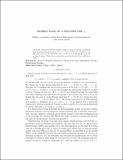Highest rank of a polytope for An
Abstract
We prove that the highest rank of a string C-group constructed from an alternating group An is 3 if n=5, 4 if n=9, 5 if n=10, 6 if n=11, and ⌊(n−1)/2⌋ if n⩾12. Moreover, if n=3,4,6,7, or 8, the group An is not a string C-group. This solves a conjecture made by the last three authors in 2012.
Citation
Cameron , P J , Fernandes , M E , Leemans , D & Mixer , M 2017 , ' Highest rank of a polytope for A n ' , Proceedings of the London Mathematical Society , vol. 115 , no. 1 , pp. 135-176 . https://doi.org/10.1112/plms.12039
Publication
Proceedings of the London Mathematical Society
Status
Peer reviewed
ISSN
0024-6115Type
Journal article
Description
This research was supported by a Marsden grant (UOA1218) of the Royal Society of New Zealand, and by the Portuguese Foundation for Science and Technology (FCT-Fundação para a Ciência e a Tecnologia), through CIDMA - Center for Research and Development in Mathematics and Applications, within project UID/MAT/04106/2013.Collections
Items in the St Andrews Research Repository are protected by copyright, with all rights reserved, unless otherwise indicated.

